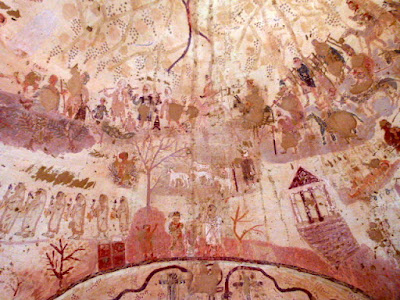
Travelling in Egypt is a constant treasure hunt; literally. You never need to go more than a few kilometres to be surprised and delighted by yet another temple, another tomb, another ancient village, where you can indulge in your childhood dreams of becoming an archaeologist/explorer/adventurer/historian/ and discovering new worlds and unknown civilizations.As you know by now, I firmly believe in Proust's suggestion that the real voyage of discovery consists not in seeking new landscapes, but seeing the world with new eyes. Thus the next few blog entries may not be new discoveries as far as the world is concerned, but they were new discoveries for me. Not only did I see them for the first time, but they were also seen for the first time...So -- join me now and go on this amazing journey with me through the ancient land of Egypt!The first surprising discovery was about 3km from the centre of el-Kharga and 1km north of the Temple of Hibis is the early Christian cemetery of Bagawat. Sprawling up the lower southern foothills of Gebel el-Teir, Bagawat is perhaps the oldest major Christian cemetery in the world and has become a main tourist attraction for Kharga Oasis.
The cemetery consists of a vast expanse of domed mudbrick mausoleums and underground galleries dating back to the 4th century AD, which were built over the site of an earlier Egyptian necropolis of pit-graves. As a burial ground Bagawat appears to have been in constant use until the 11th century, although the mudbrick structures date only up to the 7th century. The architectural style of the 263 tomb-chapels varies from simple one-room structures to family mausoleums with ornate façades enhanced with faux columns and arches and domed roofs.
The chapels were arranged in ‘streets’ and interconnecting narrow alleyways, making this one of the earliest ‘cities of the dead’. Each superstructure was constructed over a deep pit beneath the floor level which contained shelves for the coffins and funerary goods. It is interesting that some of the equipment had been re-used from earlier Egyptian burials, with painted scenes of Horus and Thoth still visible.
Although many of the chapels were undecorated and consisted simply of a single chamber built over the tomb shaft, some were much more elaborate and contained plastered walls with painted biblical scenes in a strange mixture of styles while others have elements reminiscent of earlier Egyptian architecture.
Two of the most outstanding and best preserved of the decorated chapels are named ‘Chapel of the Exodus’ and ‘Chapel of Peace’. Inside the Chapel of the Exodus, which is one of the earliest in the cemetery, the interior of the dome is decorated in two bands illustrating scenes from the Old Testament; Adam and Eve, Moses leading the Israelites through the Sinai desert in the Exodus, Pharaoh (Rameses II?) and his armies, Noah’s ark, Daniel in the lion’s den, Jonah and the whale and several other biblical episodes. In the Chapel of Peace, similar themes are depicted on the dome, including the Annunciation of the Virgin Mary and others, each identified in Greek. The interior walls are also painted with many Byzantine frescoes of grape vines, peacocks, allegorical figures and inscriptions. The purpose of the Christian tomb-chapels, like their ancient Egyptian counterparts, was for the reverence of the deceased.
Numerous Arabic graffiti dating from the 9th century to the present day can also be seen in some of the chapels, including some by Turkish soldiers thought to be garrisoned at Bagawat in the late 18th century.
In the centre of the cemetery a mud-brick church once had Christian saints depicted on its walls and at the rear niches for icons and lamps can still be seen.

























No comments:
Post a Comment